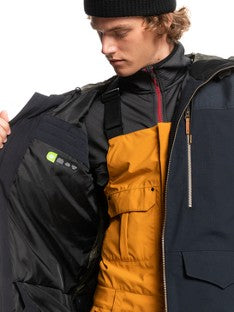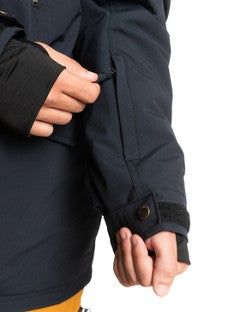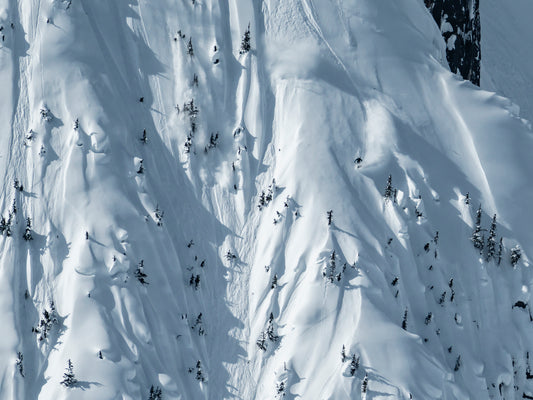There was a time when ski and snowboard culture were polar opposites, and while traditionally ski and snowboard jackets were designed with different fits, styles and sizes, their similarities have evolved over the years alongside the culture of their sports.
Read on to discover the key functions for each sport and technologies built into the snow jackets available today.
History of Snow Jackets
While skiing came much earlier than snowboarding, snow wear has always had its roots in bridging style and function. As early as the 1900s, skiers stayed warm by wearing wool suits. Comfort and mobility in snow clothing was enhanced when ski lifts were developed in the 1940s to accommodate longer rides down the mountain, and the next few decades pushed the limits in on-slope fashion with fitted silhouettes and neon jumpsuits.
Snowboarding had its beginnings in the mid-60s and was adopted by a few influential skaters and surfers who brought the style and culture of their sports to the mountain. In the 1990s, the surf industry began recognizing opportunities to incorporate the colorful look of surf clothes into the more conservative styles of ski clothing at the time.
Over the years, innovations in snow clothing technology have bridged many of the differences between ski and snowboard fashion, and what you wear on the mountain today mainly comes down to personal preference in style and fit.

Ski Jacket vs Snowboard Jacket: Fit and Style
Ski Jacket
Ski jackets come in a wide range of styles, and have key features that make them better adapted for skiing and mountain performance. Ski jackets often feature:
- A snow skirt to prevent snow from getFit & Sting into your midsection
- Fabrics that can stretch without sacrificing durability or water resistance
- Sustainable fabrics and construction techniques that reduce environmental impact
- Jacket-to-pant attachment system to connect ski jacket to your pants
- Specific pocket for your ski pass
- Vents to let out air if you begin to overheat
- Waterproof zippers to make sure your belongings stay dry while skiing in wet weather
Slim to Regular Fit: Ski jackets typically have a classic fit, and while sometimes tailored, allow enough room to layer and are comfortable to wear. The type of ski jacket you choose, whether it be a hard shell, puffy, or insulated waterproof jacket, will look a little different in style but will still feature this classic style of fit.
Snowboard Jacket
Snowboarding specific jackets offer many of the same technical features that ski jackets do. It’s common to find a snowboard jacket with:
- A snow skirt to keep snow out of your midsection
- Fabrics that can stretch without sacrificing durability or water resistance
- Sustainable fabrics and construction techniques that reduce environmental impact
- Jacket-to-pant attachment system to connect snowboard jacket to your pants
- Pass pocket for your ski pass
- Vents to ventilate heat and vapor from your body
- Waterproof zippers to keep your belongings dry
The slight differences between ski jackets and snowboard jackets are mainly due to style and fit.

Regular to Loose Fit: In the past, snowboard jackets had a looser, baggier fit than ski jackets. While snowboard jackets can still have a tapered waist, they’re typically not fitted. This loose fit was a staple of snowboarding style and can be attributed to the fact that snowboarding has its roots in streetwear. A looser fit also allows you to wear more layers underneath your jacket without feeling constricted.

Longer Fit: Snowboarder’s tend to spend time sitting on the snow adjusting their bindings. A longer jacket allows more protection from the wet and cold snow while sitting on the snow.
Ski Jacket vs Snowboard Jacket: Purpose
Nowadays, the purpose of ski jackets and snowboard jackets is essentially the same.
Ski Jacket
Ski jackets are designed for warmth and protection on the mountain. While some ski jackets feature a slimmer fit, they are designed in a way that won’t make you feel restricted when moving your body or planting your pole.
Snowboard Jacket
Snowboard jackets are also designed for warmth and protection. Although modern fabrics provide you with freedom to move, some snowboarders choose a looser style. It’s also good to look out for jackets with added length for protection when sitting in the snow and adjusting bindings.
SHOP SNOW JACKETS
Snow Jacket Technologies
While there are slight differences in the style and fit of ski jackets and snowboard jackets, they contain many of the same technologies and can be worn interchangeably for either activity.

Waterproofing
The waterproof elements of ski and snowboard jackets are the same, but some ski jackets are designed to have a more traditionally technical look, although this doesn’t mean that it will be more waterproof. Always be sure to read the label of the jacket for information on the waterproofness of the fabric. For more detail on choosing the right level of waterproofing, read “How To Choose the Right Ski Jacket”.

Insulation
Ski and snowboard jackets are not insulated differently. Whether you’re purchasing a ski or snowboard jacket, you can buy an insulated or uninsulated jacket. The choice will depend on your level of activity and riding conditions. Insulated jackets offer many options, like down insulation or synthetic insulation. Whichever you choose, just note that the insulation itself doesn’t change whether it’s a ski jacket or snowboard jacket.

Snow Skirt
A snow skirt, or a powder skirt, is an added piece of fabric that’s sewn into the inside lining of a jacket around the midsection. It fastens in the front with snaps or a zipper. The bottom of this fabric is elastic, so it stays tight to your waist. It helps to prevent snow from coming up under your jacket. This can happen frequently when skiing or riding in deep snow, when you fall down, or even when you're just sitting in powder. Because snow going everywhere is an inevitable part of getting out on the mountain, this is a common feature on both ski and snowboard jackets.

Helmet Compatible Hoods
Many ski and snowboarding jackets have a hood that is slightly larger than a normal winter jacket. This is so your hood fits comfortably over your helmet while you’re on the mountain, and is a common feature on both ski and snowboard jackets. On cold or windy days, pulling your hood over your helmet can make you much warmer, as it further protects your neck and face from the cold.

Pass Pocket
A useful feature on both ski and snowboard jackets is a lift pass-specific pocket. This is a small pocket, usually on the left outer sleeve, that’s designed to hold your lift ticket and nothing else. It’s a great feature as most lift pass systems use electronic sensors, and it also helps you keep track of where your pass is.

Vents
Vents are another common feature of ski and snowboard jackets. Vents are zippered openings that you can unzip when you need to cool down, and are often located under the arms and on the side of the waist. Vents are found in the same places on ski and snowboard jackets, and have the same purpose of cooling you down no matter what sport you’re doing.

















